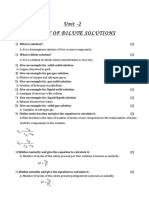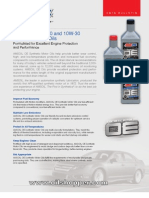0% found this document useful (0 votes)
77 views2 pagesSolution in One Page
Solutions can be classified as solid solutions, liquid solutions, or gaseous solutions. Henry's law states that the solubility of a gas in a liquid is directly proportional to the pressure of the gas. According to Raoult's law, the partial vapor pressure of each component in a solution is directly proportional to its mole fraction. Colligative properties such as lowering of vapor pressure, boiling point elevation, and freezing point depression depend only on the number of solute particles and not on their identity. Osmosis is the flow of solvent through a semipermeable membrane from a region of lower solute concentration to higher solute concentration. The osmotic pressure is the pressure required to stop osmosis
Uploaded by
raiprisha06Copyright
© © All Rights Reserved
We take content rights seriously. If you suspect this is your content, claim it here.
Available Formats
Download as DOC, PDF, TXT or read online on Scribd
0% found this document useful (0 votes)
77 views2 pagesSolution in One Page
Solutions can be classified as solid solutions, liquid solutions, or gaseous solutions. Henry's law states that the solubility of a gas in a liquid is directly proportional to the pressure of the gas. According to Raoult's law, the partial vapor pressure of each component in a solution is directly proportional to its mole fraction. Colligative properties such as lowering of vapor pressure, boiling point elevation, and freezing point depression depend only on the number of solute particles and not on their identity. Osmosis is the flow of solvent through a semipermeable membrane from a region of lower solute concentration to higher solute concentration. The osmotic pressure is the pressure required to stop osmosis
Uploaded by
raiprisha06Copyright
© © All Rights Reserved
We take content rights seriously. If you suspect this is your content, claim it here.
Available Formats
Download as DOC, PDF, TXT or read online on Scribd
/ 2























































































